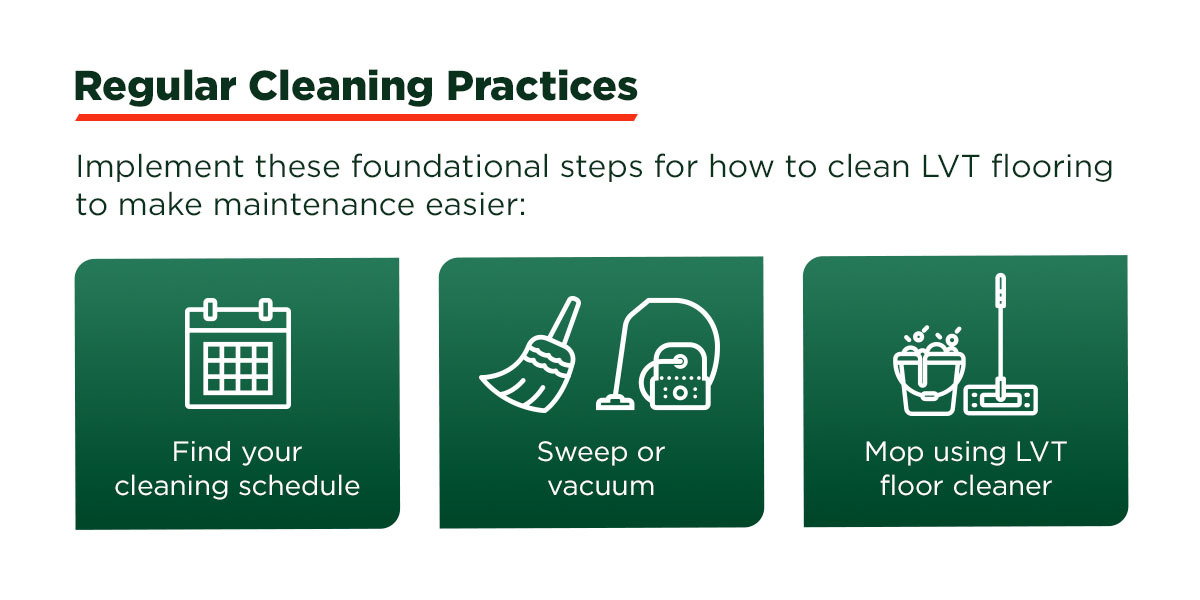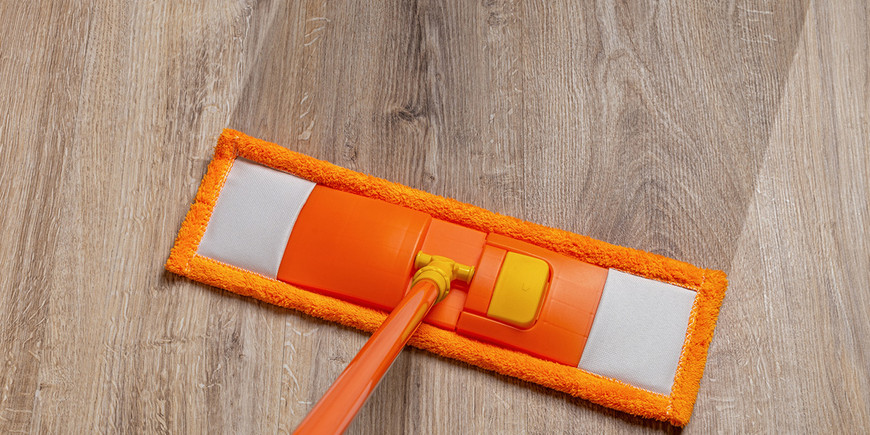How to Clean and Maintain LVT Flooring
Posted by Ben Garelick (@BlueShirtBenny) on 21st May 2025
Luxury vinyl tile (LVT) is a popular flooring option thanks to its cost-effectiveness, aesthetic versatility, durability and easy installation.
LVT is also low-maintenance, but understanding how to clean and maintain LVT flooring is essential for extending its lifespan and creating the perfect look around your home. Thankfully, a good cleaning routine is straightforward and easy! You can enjoy floors that last for years without spending hours obsessing over cleaning them.
Why a Cleaning and Maintenance Routine Is Important for Your LVT Floors
Caring for your LVT floors is about more than simply having a clean home. A cleaning and maintenance routine contributes to the following:
- Longevity: Caring for your floors minimizes and prevents wear and tear. Your floors can remain in good condition for longer when you have a solid cleaning and maintenance routine.
- Appearance: Without cleaning, dirt and stains can accumulate over time, leaving your floors with a dull and worn look. Regular maintenance helps keep your floors looking vibrant.
- Hygiene and health: Regular cleaning helps you keep your floors free of bacteria and allergens from dust and dander. Clean floors significantly contribute to a healthier living space and better air quality.
- Long-term savings: Without regular maintenance, your floors may experience wear and tear to the point that you need frequent repairs or premature replacement. You can avoid these expenses by caring for your floors as needed.
- Ease of routine: Cleaning your floors regularly makes your routine more efficient. Dirt and grime will not build up as much, and stains won't set.
Regular Cleaning Practices
Your cleaning schedule ultimately depends on your home and how much wear your floors experience. However, you can implement these foundational steps for how to clean LVT flooring to make maintenance easier:
- Find your cleaning schedule: For many homes, cleaning LVT floors with a mop once per week is sufficient. However, this varies — if you have pets, young children and a generally busier household, cleaning every few days may be necessary. If, on the other hand, your house does not experience a lot of heavy foot traffic, you may only need to mop every week. Either way, sweeping or vacuuming every day or so is beneficial.
- Sweep or vacuum: One of the best parts of having LVT flooring is low-maintenance cleaning. Generally, you need nothing more than a soft-bristled broom or an appropriate vacuum and a mop to keep your LVT floors clean. If you do use a vacuum, use a soft sweeping attachment and ensure that it does not have a beater bar.
- Mop using LVT floor cleaner: Unless you need to clean spills, you likely need only mop once or twice a week. Keep the mop damp, not soaking wet, as excess moisture can seep into the seams of the flooring and cause damage. You can add a cleaning solution specifically made for LVT to the water.

Spot Cleaning Your Floors
Spot cleaning is an essential part of a floor maintenance routine. Spills and stains from food, pet accidents or kids' playtimes are bound to happen sometimes. You can spot clean more effectively with the following basic steps:
- Whenever possible, address spills and stains immediately. The quicker you get to stains, the easier they are to remove.
- Blot the stain or spill using a damp microfiber cloth or a paper towel. Blotting is better than rubbing, as it prevents the stain from spreading.
- Add a few drops of mild dish soap or a pH-neutral, LVT-suitable cleaner to some warm water.
- Dampen your cloth with the cleaning solution and wring out extra water.
- Work from the outside of the stain to the center as you clean it to avoid spreading it.
- Clean your cloth with clean water, rinse it out properly and wipe the area to remove any residue.
- Use a clean, dry cloth or paper towel to blot the area completely dry.
Preventing Dirt, Debris and Damage
Preventing a buildup of dirt and grime is essential for enjoying beautiful, spotless floors. Adding some preventive measures to your cleaning routine also helps you minimize the amount of work you need to do.
Two easy but effective solutions you can explore are using area rugs and doormats and implementing shoe policies. Area rugs are a versatile solution for protecting your LVT floors. They can protect your floor from spills, scratches and scuffs and also add another dimension of beauty, warmth and depth to your space. You might also use furniture pads or felt protectors to protect your floors from scratches and dents.
Having a doormat at your entrance can help prevent you and your guests from tracking debris into the home. And if you love hosting and having people in and out of your home, then a no-shoe policy is something you should definitely consider! Taking shoes off before entering a house is a significant part of many cultures, and it helps keep a home clean. Outside shoes are a huge culprit when it comes to tracking dirt into your home.
Deep Cleaning Your LVT Floors
How Often Should I Deep Clean LVT Floors?
Your LVT floors will thank you if you indulge them with periodic deep cleans that help maintain their appearance. For high-traffic areas, it can be helpful to deep clean every three to six months or as needed in between.
How to Deep Clean LVT Floors?
A deep cleaning routine does not need to deviate very much from your regular cleaning. There are no extra steps, equipment or products needed to deep clean your LVT floors! Deep cleaning simply means dedicating more time to ensuring that all dirt, debris and stains are removed. When deep cleaning, you should be as gentle with your LVT floors as you usually would.
A few tips to keep in mind to protect your floors include:
- Avoiding steamers: Using a steamer to deep clean is not recommended, as it can cause heat and moisture damage and also void your warranty. A broom, mop, microfiber cloth and gentle cleaning solution are sufficient for deep cleaning.
- Skipping harsh chemicals: It is also best to avoid bleach, ammonia and other abrasive cleaners. These can damage the floor's finish.
- Avoiding wax: Wax-based products are also not appropriate. They can make the surface slippery, compromise the floor's finish and cause a buildup of residue that that dulls the floors over time. Wax-based products are also difficult to remove without abrasive products, so it is best to avoid them altogether.
When to Seek Professional Help with Cleaning LVT Floors
Your LVT floors may show minor scratches from heavy foot traffic and long-term wear and tear. This is completely normal — especially if you have a busy home! You can get DIY LVT scratch repair kits for minor scratches, which contain products like dent fillers or putty.
If your floors are peeling or have extensive scratches, big dents or water damage, it is best to consult a professional. They understand the intricacies of subflooring issues and when replacements may be the better option over repairs. A professional will also be able to fix your floors in compliance with your warranty terms, giving you greater peace of mind.
Shop Carpet & Tile Mart for High-Quality LVT Flooring
The best way to clean LVT flooring is consistently and gently. You can retain the quality and appearance of your floors by using simple cleaning products and implementing good household habits like a no-shoe policy. By maintaining a good cleaning routine, you can get the best out of your LVT flooring without countless hours of cleaning.
At Carpet & Tile Mart, we have a wide range of excellent flooring options at competitive prices. Whether you are looking for area rugs to protect your LVT floors or new LVT flooring options, our help team can help you find the best flooring products for your home. We also collaborate with knowledgeable contractors who can professionally install, repair and replace your LVT flooring.
Shop our products online now, or visit a Carpet & Tile Mart store near you.




